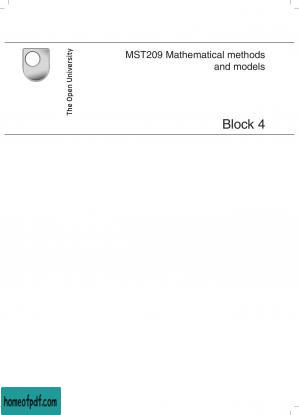MST209 - Mathmatical Methods and Models - Block 4
该资源由用户: 梅花博明 上传 举报不良内容

尊敬的读者:
欢迎您访问我们的网站。本站的初衷是为大家提供一个共享学习资料、交换知识的平台。每位用户都可以将文件上传至网盘并分享。
然而,随着用户上传的资料增多,我们发现部分不宜或版权问题的书籍被分享到了本站。
为此,我们已经关闭了分享入口,并进行了多次书籍审查,但仍有部分内容未能彻底审查到位。
在此,我们恳请广大读者与我们共同监督,如发现任何不宜内容,请 点击此处 进行举报,我们会第一时间处理并下架相关内容。
希望我们能共建一个文明社区!感谢您的理解与支持!
猜你喜欢

《操弄》布特妮.凱瑟
View more
《操弄》布特妮.凱瑟

Dreamweaver CS6 Mobile and Web Development with HTML5, CSS3, and jQuery Mobile - David Karlins
View more
Dreamweaver CS6 Mobile and Web Development with HTML5, CSS3, and jQuery Mobile - David Karlins

《母慈子孝 》赵良玉中华文化大讲堂书系文字版
View more
《母慈子孝 》赵良玉中华文化大讲堂书系文字版

《古今名医药论》罗美
View more
《古今名医药论》罗美

《回头客战略:交易额越高,流量成本越低的经营模式》
View more
《回头客战略:交易额越高,流量成本越低的经营模式》

Red Hat Enterprise Linux 5 Administration Unleashed - Tammy Fox
View more
Red Hat Enterprise Linux 5 Administration Unleashed - Tammy Fox

《山河犹存:陈舜臣带你读史(套装共10册)》陈舜臣
View more
《山河犹存:陈舜臣带你读史(套装共10册)》陈舜臣

《全球通史(全二册)》海斯时间的轨迹-不可遗忘的历史系列美国大中院校指定世界史著作彩插精装版
View more
《全球通史(全二册)》海斯时间的轨迹-不可遗忘的历史系列美国大中院校指定世界史著作彩插精装版

Mastering Kubernetes - Gigi Sayfan
View more
Mastering Kubernetes - Gigi Sayfan

《英语词根与单词的说文解字》李平武
View more
《英语词根与单词的说文解字》李平武

《康德文集(注释版)(套装共10册)》伊曼努尔·康德修订版
View more
《康德文集(注释版)(套装共10册)》伊曼努尔·康德修订版

《全球证券投资经典译丛(套装共16卷)》拉尔夫·N·艾略特 等珍藏版
View more
《全球证券投资经典译丛(套装共16卷)》拉尔夫·N·艾略特 等珍藏版


